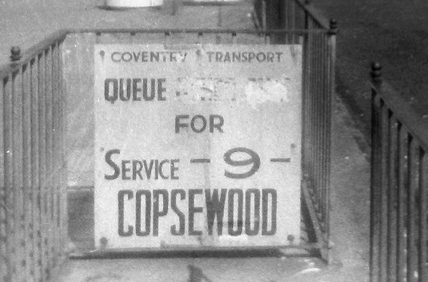

The simplest bus stop was a single, vertical, galvanized steel pole, about 2.4 m (8 feet) high and approximately 6 cm (2½ inches) in diameter. At the top of the pole, on the side of facing away from the road, a vertical steel disk about 50 cm (20 inches) in diameter was attached by two lugs. The disk was attached to the pole by its edge so that sides faced up and down the road. A typical bus stop is shown here.

Fare stages, like the one illustrated in Fig 1, were maroon with cream writing. Request stops were cream with maroon writing. The word "STOP" was usually, but as in this case not always, replaced with the service number and destination. The final stop on a route was usually labelled "All Passengers Alight Here". The bus stop at the start of a route may have been labelled "Buses for ... Start Here" or "Queue Here for Buses to ... ". Works bus stops bore the words "Works Buses". The majority of stops were of the simple type. All the different types of stops incorporated a bus stop pole, as described above, except those on the North and West Sides of Broadgate, which used steel railings (see below).
Crush Barriers were sometimes attached to the bus stop pole. Typically, a crush barrier consisted of four galvanised steel uprights, of which the bus stop pole was one, spaced about 1.8m (6 feet) apart running along the line of the curb. These were joined by horizontal bars, connected by right-angled connectors, one across the top, about 1.2m (4 feet) above the pavement and one about half way up. Later crush barriers had one horizontal at the top and one near the bottom, with a galvanized steel grill covering the outside of the barrier. In city centre locations, the crush barriers could be longer. Passengers waiting for the bus would queue behind the barrier, with the head of the queue at the end where the stop pole was located. Although no record can be found about the reason for installing the barriers, they were usually located in places where there would be many passengers queuing and a lot of traffic in the road. There were many of these in the city centre and they were also found at locations such as in the Butts, outside the technical college. An example of the later type of crush barrier stop is shown in Figure 2.

Bus shelters consisted of between three and five vertical poles 2.1 (about 7 feet) high both at the front and back of the shelter. One of the front poles, usually the left as you faced the road, was the bus stop pole and, therefore, higher than the rest. The length of the shelters (along the curb) was variable, but usually they were about 6m (20 feet) long. The depth of the shelters from the curb back across the pavement was generally about 1.5m (5 feet). The tops of the poles were connected by horizontal poles, and there was another middle row of horizontal poles about 1.2 m( 4 feet) above the pavement. There was no front middle pole connected to the bus stop pole, to allow passengers to board the bus. Also, sometimes, there was no middle pole along the back or at the ends. Usually, the space between the middle pole and the ground was filled with a sheet steel panel. There was a roof of corrugated material. Unlike crush barrier stops, the poles were painted cream and the front panels were painted maroon. Often, the shelter had a set glass or perspex panels at the rear above the middle rail. Along a narrow panel at the top of the front (road) side of the shelter, the service number and destination were usually painted, especially in the city centre.

Bus shelters were located stretegic points, such as the City-bound Service 9 stop at Earlsdon Library, the Servce 8 Terminus in Tile Hill Village and the Service 5 City-bound stop at Westhill Road shops. The four stops on the East side of Broadgate, to the South of Trinity Row, all had shelters, as did all the stops in Pool Meadow.
Along the North and West Sides of Broadgate there were steel railings, presumably to separate the large number of shoppers from the traffic. The railings consisted of top and bottom flat bars with vertical, cylindrical bars between them. The vertical bars were spaced about every 10 to 15cm (4 to 6 inches). About every 1.2m (4 feet) there was a flat upright that was anchored into the pavement. In order to allow the buses to set down and pick up passengers, the railing had openings, which were protected by another set of railings that projected in away from the curb. These then turned at right angles to prevent a passer-by from being thrust through the opening. A special, rectangular bus stop sign was attached to the railings, as shown in Figure 4.

Figure 1: Kevin Tulley
Figure 2: Graham Bailey
Figure 3: Coventry History Centre, Coventry Heritage & Arts Trust Ltd.
Figure 4: Kevin Tulley